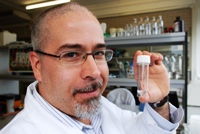Potential new therapeutic targets for Schistosomiasis

Professor Karl Hoffmann
10 August 2011
Scientists from Aberystwyth University have made a significant discovery that could pave the way for the development of a new drug treatment for one of the world’s deadliest diseases.
In a paper entitled Cytosine methylation regulates oviposition in the pathogenic blood fluke Schistosoma mansoni which is published in Nature Communications on Tuesday 9 August 2011, Professor Karl Hoffmann from the University’s Institute of Biological, Environmental and Rural Sciences outlines how they have identified a specific DNA modification of the parasitic flatworm Schistosoma mansoni that gives rise to the disease schistosomiasis.
A chronic and debilitating disease caused by blood flukes, schistosomiasis kills 300,000 people each year, a death toll second only to malaria among parasitic diseases, and leaves more than 200 million people chronically ill.
Professor Hoffmann and colleagues show for the first time that genomic DNA of the blood fluke Schistosoma mansoni is methylated and go on to identify the protein (a DNA methyltransferase) that is likely to mediate this process.
DNA methylation (attachment of a methyl group to one of four nucleobases that make up an organism’s DNA) is considered to be one of the most important genome modifications in nature and is involved in developmental biology, gene expression regulation and phenotypic diversity.
The scientists found that chemical inhibition of the DNA methylation machinery with the FDA approved chemotherapeutic drug 5-azacytidine (5-AzaC) dramatically reduced egg production of female blood flukes and caused developmental defects within the remaining eggs.
As eggs are responsible for the pathology associated with schistosomiasis and transmission of the disease, these findings suggest that targeting of the proteins that methylate DNA within the blood fluke could be used in their control.
Professor Hoffmann said: “In terms of the impact on people’s lives this disease exceeds TB, malaria and is on a par with AIDS in terms of disease burden. It has a major impact on what they can do. They can’t go to school, they can’t work, and they’re in constant pain.”
“This discovery in the way in which schistosome genes may be modified is incredibly exciting as it simultaneously opens up a new approach for schistosomiasis control but also provides evidence that illustrates an important functional role for this specific modification in the development of a parasitic worm species.”
The research has been funded by the Wellcome Trust and the Sandler Center for Basic Research in Parasitic Diseases.
AU17011



